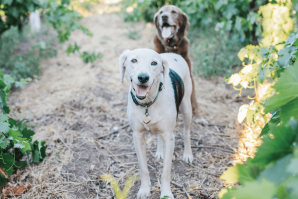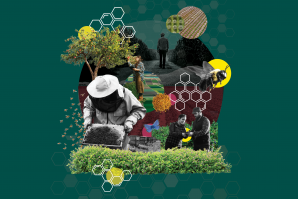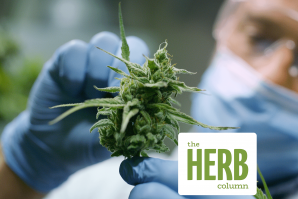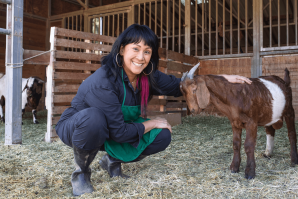Grafting European-origin grapevines to North American rootstock has been standard practice in vineyards worldwide since the 19th century. These Vitis vinifera grapes — chardonnay, cabernet sauvignon are probably the most familiar — make palate-pleasing, flavorful, complex, high-quality wine. American grapes, not so much.
The rootstock of indigenous North American grape vines (same Vitis genus with over two dozen different species coming from a wide, diverse geographic range) excels at resisting disease and has proven to be reliably adaptable to a range of growing conditions most of the time. Yet, climate changes. Pests mutate. Plant diseases spread and remain resistant to treatment or impossible to cure. These and other challenges keep growers and producers on quests for improvement. More knowledge makes for better vineyard conditions, better plant materials, better growing practices. And better wine.
Research conducted by an international team of plant biologists and others at UC Davis between 2018 and 2023 explored the genetic diversity of North American wine grapevines, decoding and cataloging the characteristics of nine species. The knowledge gained is a great leap up the learning ladder for the wine industry. Scientific findings have unlocked critical information and illuminated greater understanding of key plant genes, promising leads to improved grape breeding.
These experts created the first ever comprehensive pangenome — mapping genetic diversity, isolating specific traits, identifying similarities and differences among the species. The pangenome is a blueprint that will allow breeders to select rootstock by its genetic propensity for specific desired traits — say, drought tolerance or heat resistance.
Noé Cochetel, a postdoctoral researcher on the team, did the analysis for the study, and Genome Biology, a leading peer-reviewed scientific journal, published an article summarizing the study results. Plant biologist Dario Cantù, professor in the UC Davis Department of Viticulture and Enology, holder of the Louis P. Martini endowed chair, says he supervised and coordinated the project, but “the person that should take credit for the work is Noé Cochetel. … He is a talented plant biologist, trained in genetic and genomic analysis with long experience working with grapevines.”
The National Science Foundation provided major funding for the research that led to creation of the genetic map, along with support from major wineries, growers and producers. The completed study “offers tremendous potential for advancing sustainable grape cultivation,” says Cantù, “especially in regions facing water scarcity challenges.”
With this detailed pangenome, breeders will now be able to selectively incorporate desired traits, such as salt tolerance, while avoiding less desirable characteristics. “Salt tolerance is a crucial trait for rootstocks. “Identifying these traits at a genetic level is a major advancement for grape breeding,” he says.
“The super-pangenome will serve as a reference for numerous other traits, ranging from drought tolerance to resistance against Pierce’s disease,” Cantù explains. Pierce’s disease, spread by insect vector, has been threatening, sometimes devastating, to vineyards in warm regions such as Temecula in southern California.
Spencer Jones, winemaker and viticulturist at his family’s Iron Hub Winery in Plymouth, farms 32 acres of chardonnay, sauvignon blanc, sangiovese, syrah, zinfandel and more in the cool-climate Sierra foothills. He has water concerns, as do many other growers for whom choices in the vineyard can be delicate balancing acts. “Salt content can be a problem with reclaimed water,” says Jones. Then there is rainfall. “Half of my acres are dry-farmed (no irrigation), which I can do after the vines are about 30 years old.”
As vines mature, they can put down roots deep enough to tap into groundwater, which also conveys minerals that add intensity, nuance and distinctive character to wine. “Drought tolerance (of rootstock) is crucial,” Jones says, adding that 30 inches of rainfall is average and optimal for the deep-rooted dry-farmed vineyards. “But rainfall last year was 60 inches. So I’m looking for rootstock that is vigorous. Also, water uptake in late summer is very important to prevent grape clusters from shriveling,” he adds.
Jones, who received his MS in viticulture and enology at UC Davis and studied with Dr. Cantù, also serves as president of Amador Winegrowers Association. He is enthused about what this kind of scientific project means for making more informed choices that will improve vineyard practice and management among his colleagues. “This research project on further development of rootstocks is very exciting, especially as climate change continues to present new challenges for farmers,” he says.
Stay up to date on business in the Capital Region: Subscribe to the Comstock’s newsletter today.
Recommended For You

Going to the Dogs
Lodi vineyards and nurseries test canine pest detection
The solution to one of the wine industry’s most costly and threatening problems may be coming soon from Lodi — and it will trot out on four feet, tails a-wagging, with noses keener than even advanced scientific equipment.

Give Bees a Chance
Farmers restore habitat for native pollinators
As California grew into a vast agricultural region during the early 20th century, native grasslands, forests and riparian habitats were gradually replaced by farmlands and orchards. Though green things thrive on farms as a matter of business, there’s very little biodiversity on a traditional farm — and not much room for pollen specialists.

The Herb Column: Curbing the ‘COVID of the Plant World’
Cannabis growers battling hop-latent viroid that threatens their harvest
A sneaky viroid has been spreading invisibly for months at a time in cannabis plants across the country, decimating crops right as they’re about to flower. The so-called hop latent viroid is now the “biggest concern for cannabis growers worldwide,” according to a recent scientific paper.

Rest and Reset at the Reimagination Farm
Former UC Davis professor Robyn Rodriguez starts a sanctuary space dedicated to healing
It’s harvest time at the Reimagination Farm in Lake County,
California. As autumn turns the air crisp and the leaves begin to
change, former UC Davis Asian American Studies professor Robyn
Rodriguez surveys the land in front of her and reflects on the
rhythms of nature. “Even the earth follows cycles of rest,” she
muses. “That’s how we regenerate.”



